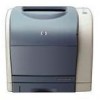HP 2500 HP PCL/PJL reference - Printer Job Language Technical Reference Manual - Page 331
PJL Current Environment, PJL Job, PJL Reset Condition, Poorly Formed Print Job, Print Environment
 |
View all HP 2500 manuals
Add to My Manuals
Save this manual to your list of manuals |
Page 331 highlights
PJL Current Environment The PJL Current Environment is the set of features that is active when a PJL job is entered. As soon as a PJL job is entered, the PJL Current Environment settings are the same as the User Default Environment. Applications then can modify the PJL Current Environment values using the PJL SET command. The PJL Current Environment provides a base set of values when entering a printer language. PJL Job A PJL job is any print job containing PJL commands. Properly formed PJL jobs always begin and end with the UEL command. PJL Reset Condition A PJL reset condition prompts the printer to load the User Default values into the PJL Current Environment, which are then loaded into the Modified Print Environment. In this document, the term PJL reset condition refers to any of the following events: a power-on, UEL command (when not between a JOB/EOJ command pair), the @PJL INITIALIZE, @PJL RESET, @PJL JOB, or @PJL EOJ commands. Also included are other printer-specific events, such as control panel reset, a printer language-specific exit command (when not between a JOB/EOJ pair), such as ^D for PostScript, and data stream idle timeouts (see Appendix A for information about job boundaries and timeouts for the HP LaserJet 4 and 5 printer families). Poorly Formed Print Job A print job which either starts or ends with an invalid data stream sequence. For example, any job that does not begin and end with a UEL command is a poorly formed job. This manual describes how to create properly formed print jobs and contains many examples to demonstrate them. See Chapters 1 - 3 and Chapter 11 for more information about creating well-formed jobs. Print Environment The group of all the printer's current feature settings, collectively, is referred to as the print environment. The print environment is modified using printer commands and control panel settings. EN Glossary-5















